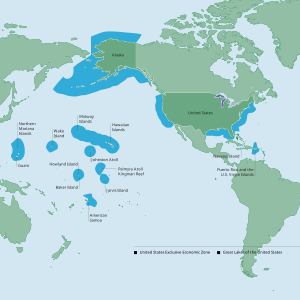

The United States has the world's second-largest exclusive economic zone (EEZ). The total size is 11,351,000 km2 (4,383,000 sq mi)2.[1] Areas of its EEZ are located in three oceans, the Gulf of Mexico, and the Caribbean Sea. Most notable areas are Alaska, Hawaii, the East Coast, West Coast and Gulf Coast of the United States.

The EEZ borders with Russia to the north west, Canada to the north, Cuba, Bahamas, Mexico to the south, Dominican Republic, British Virgin Islands, Anguilla to the south east and Samoa, Niue to the south west. The unincorporated territoriesofGuam, Puerto Rico, U.S. Virgin Islands and Northern Mariana Islands are included.
| Territory | EEZ area (km2) | EEZ area (sq mi) | Notes |
|---|---|---|---|
| 3,770,021 | 1,455,613 | A non-contiguous state in the northwest extremity of the North American continent. | |
| 1,579,538 | 609,863 | Including Midway Atoll, these islands form the Leeward Islands of the Hawaiian island chain. | |
| 915,763 | 353,578 | The mainland coastal states of the Eastern United States. | |
| 895,346 | 345,695 | These islands form the Windward Islands of the Hawaiian island chain. | |
| 825,549 | 318,746 | The mainland coastal states of the Western United States. | |
| 749,268 | 289,294 | An organized unincorporated Commonwealth of the United States. | |
| 707,832 | 273,295 | The mainland coastal states of the Southern United States. | |
| 442,635 | 170,902 | ANational Wildlife Refuge in the U.S. Minor Outlying Islands. | |
| 434,921 | 167,924 | Including | |
| 407,241 | 157,237 | A National Wildlife Refuge in the U.S. Minor Outlying Islands. | |
| 404,391 | 156,136 | The only inhabited unorganized unincorporated territory of the United States. | |
| Palmyra Atoll and Kingman Reef | 352,300 | 136,000 | Both territories are National Wildlife Refuges in the U.S. Minor Outlying Islands. |
| 316,665 | 122,265 | A National Wildlife Refuge in the U.S. Minor Outlying Islands. | |
| 221,504 | 85,523 | An organized unincorporated territory of the United States. | |
| 177,685 | 68,605 | An organized unincorporated Commonwealth of the United States. | |
| 33,744 | 13,029 | An organized unincorporated territory of the United States. | |
| N/A[note 1] | N/A[note 1] | A National Wildlife Refuge in the U.S. Minor Outlying Islands. | |
| Total | 11,351,000 | 4,383,000 |
A wedge-shaped section of the Beaufort Sea is disputed between Canada and the United States, because the area reportedly contains substantial oil reserves.[6]